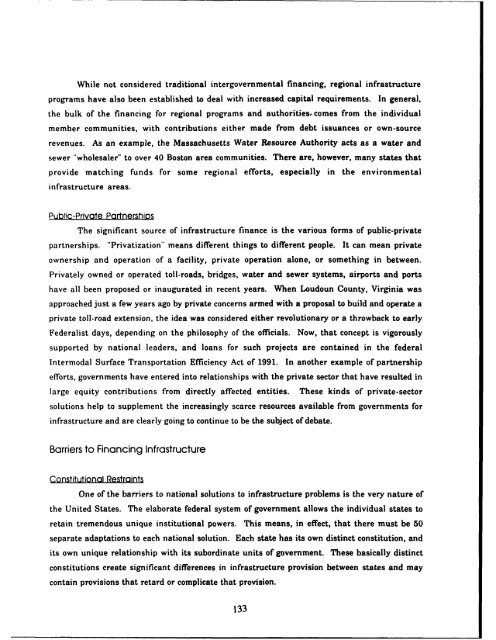Challenges and Opportunities for Innovation in the Public Works ...
Challenges and Opportunities for Innovation in the Public Works ...
Challenges and Opportunities for Innovation in the Public Works ...
You also want an ePaper? Increase the reach of your titles
YUMPU automatically turns print PDFs into web optimized ePapers that Google loves.
While not considered traditional <strong>in</strong>tergovernmental f<strong>in</strong>anc<strong>in</strong>g, regional <strong>in</strong>frastructure<br />
programs have also been established to deal with <strong>in</strong>creased capital requirements. In general,<br />
<strong>the</strong> bulk of <strong>the</strong> f<strong>in</strong>anc<strong>in</strong>g <strong>for</strong> regional programs <strong>and</strong> authorities, comes from <strong>the</strong> <strong>in</strong>dividual<br />
member communities, with contributions ei<strong>the</strong>r made from debt issuances or own-source<br />
revenues. As an example, <strong>the</strong> Massachusetts Water Resource Authority acts as a water <strong>and</strong><br />
sewer "wholesaler" to over 40 Boston area communities. There are, however, many states that<br />
provide match<strong>in</strong>g funds <strong>for</strong> some regional ef<strong>for</strong>ts, especially <strong>in</strong> <strong>the</strong> environmental<br />
<strong>in</strong>frastructure areas.<br />
<strong>Public</strong>-Private Partnerships<br />
The significant source of <strong>in</strong>frastructure f<strong>in</strong>ance is <strong>the</strong> various <strong>for</strong>ms of public-private<br />
partnerships. "Privatization" means different th<strong>in</strong>gs to different people. It can mean private<br />
ownership <strong>and</strong> operation of a facility, private operation alone, or someth<strong>in</strong>g <strong>in</strong> between.<br />
Privately owned or operated toll-roads, bridges, water <strong>and</strong> sewer systems, airports <strong>and</strong> ports<br />
have all been proposed or <strong>in</strong>augurated <strong>in</strong> recent years. When Loudoun County, Virg<strong>in</strong>ia was<br />
approached just a few years ago by private concerns armed with a proposal to build <strong>and</strong> operate a<br />
private toll-road extension, <strong>the</strong> idea was considered ei<strong>the</strong>r revolutionary or a throwback to early<br />
Federalist days, depend<strong>in</strong>g on <strong>the</strong> philosophy of <strong>the</strong> officials. Now, that concept is vigorously<br />
supported by national leaders, <strong>and</strong> loans <strong>for</strong> such projects are conta<strong>in</strong>ed <strong>in</strong> <strong>the</strong> federal<br />
Intermodal Surface Transportation Efficiency Act of 1991. In ano<strong>the</strong>r example of partnership<br />
ef<strong>for</strong>ts, governments have entered <strong>in</strong>to relationships with <strong>the</strong> private sector that have resulted <strong>in</strong><br />
large equity contributions from directly affected entities. These k<strong>in</strong>ds of private-sector<br />
solutions help to supplement <strong>the</strong> <strong>in</strong>creas<strong>in</strong>gly scarce resources available from governments <strong>for</strong><br />
<strong>in</strong>frastructure <strong>and</strong> are clearly go<strong>in</strong>g to cont<strong>in</strong>ue to be <strong>the</strong> subject of debate.<br />
Barriers to F<strong>in</strong>anc<strong>in</strong>g Infrastructure<br />
Constitutional Restra<strong>in</strong>ts<br />
One of <strong>the</strong> barriers to national solutions to <strong>in</strong>frastructure problems is <strong>the</strong> very nature of<br />
<strong>the</strong> United States. The elaborate federal system of government allows <strong>the</strong> <strong>in</strong>dividual states to<br />
reta<strong>in</strong> tremendous unique <strong>in</strong>stitutional powers. This means, <strong>in</strong> effect, that <strong>the</strong>re must be 50<br />
separate adaptations to each national solution. Each state has its own dist<strong>in</strong>ct constitution, <strong>and</strong><br />
its own unique relationship with its subord<strong>in</strong>ate units of government. These basically dist<strong>in</strong>ct<br />
constitutions create significant differences <strong>in</strong> <strong>in</strong>frastructure provision between states <strong>and</strong> may<br />
conta<strong>in</strong> provisions that retard or complicate that provision.<br />
133







